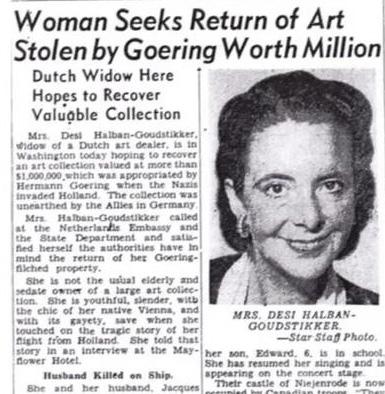
4 minute read
Our True Holocaust Inheritance
Of course, there were photographs, just a few, windows to the past. The family next door had oval miniatures and large portraits of ancestors, horsehair couches, and Eastlake settees. Our furniture was brand new, with price tags still attached.
Our photos were not displayed but buried deep in drawers. The day my mother was buried in 1990, we found one hidden near her desk, which she might have secretly looked at. An image of herself, maybe twelve, her younger sister and brother and parents, staring not so much into the camera as into a future they alone could see. Regina Kawer, my mother, not much for jewelry, nevertheless always wore an amethyst necklace. Only after her death, when her sister, Maria, the only other surviving member of the family, requested it, did we realize it had been their mother’s. When my aunt Maria died (her real name was Edith, but she kept the name she passed under), the necklace was lost since she had not told her children either of its family past. It was a past neither she nor my mother could speak of, but which they literally carried next to their hearts, a past summed up in one word, the Holocaust, a black hole that swallowed grandparents, cousins, and whole families.
But, oddly, not some objects.
There were other “survivors”: a vast set of Meissen blue onion china in a cabinet, crowned with a turreted tureen, served with a salt cellar, stacked with plates and platters. And scores of pieces of heavy old silver, dinner forks, lunch forks, fish forks, matching knives, and spoons. The blue crossed swords on the Meissen suggested various centuries, and the silver had hallmarks, one from post-war Vienna, the other too obscure to read. (Buried outside Warsaw, and dug up after the war, the corroded metal had to be recast is what my mother told me.)
The silver had survived; but the son she had buried with her own hands had not.
The china and silver came out occasionally, mostly at Passover and once when family from those who had emigrated before the war gathered from other continents. But the Meissen was usually locked up; my mother favored breakfronts with keys, and glass with latticed metal, like prison bars, guarding the contents. I have no idea what she thought of when she saw it — did it bring back images of Shabbos meals, latkes and Passovers? How could porcelain survive when her parents had perished? She wept inconsolably when a leg of the salt cellar snapped. I glued it back for her, a symbolic act I now see, for we children of Holocaust survivors often felt the need to mend a broken world for our parents, by being, breathing, succeeding. The china, the silver, her grandmother’s earrings, which I have in a safety deposit box for my nieces, are just things, but they’re powerful amulets, as rare as moon rocks, objects to render a lost universe. When none of us are left to remember their stories, will they be inert and dead, too, trinkets tossed in a second hand shop, like the amethyst necklace? I know not; all I know is that they are part and parcel of the many things my parents passed more unwillingly to me. Is it in my genes? I have the same fears that haunted them, the same need to find lost things no matter how insignificant, the ability to see doom in the most minor mishaps. Five minutes late translates into a death on the highway. Born in America, knowing only comfort and ease, I have inherited a dread of chaos erupting to devour order and sanity; it is also present in the generation behind me.
But it is redeemed with the need to tell their stories, to keep their past from repeating, to stop other Holocausts from happening. When I see the silverware in drawers, the forks stacked orderly, spoons cradled in one another, different images come to mind: tangled corpses of concentration camp
HARLAN GREENE bodies tumbled chaotically. My ancestors who held that buried silver never had a burial ceremony.
How is one to reconcile such an irony? People are murdered; we polish their silver.
The photos, the salt cellar with its glue mark make me weep. But they remind me to fight for justice and against genocide still rising, to fix a world in need of mending. Isn’t this our true Holocaust inheritance, not china, not silver, not an amethyst necklace? ■
Front row, left to right: my mother’s mother, brother and father, all born in Warsaw. Kayla (Kalah) Miedzyrzecki Kawer (1898-1942), Eleazer Kawer (1925-1942) and Moshe David Kawer (18821942). Back row, left to right, my aunt and my mother: Maria Godlewska (Yehudit) Kawer (1922-2003) and Regina (Ruchel) Kawer (1920-1990). Regina Kawer Greene, born in Warsaw, Poland (1920-1990) and Samuel Greene, born in Slawatycze, Poland (1914-2013) were married in Europe in 1939 and came to the US after the war in 1948.


Photo taken in my father Samuel’s hometown of Slawatycze, probably about 1930. The boy in the first row, sitting, the second from the left, is believed to be Samuel. The names and fates of the others are unknown. Most of the Jews of that town did not survive.










